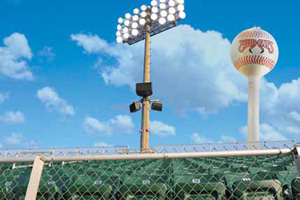Heavy Hitter

The New Audio System At North Carolina’s Five County Stadium Is A Home Run
ZEBULON, NC—Five County Stadium, home to the Carolina Mudcats (the Double-A affiliate of the Cincinnati Reds major-league baseball club), has undergone an extensive sound reinforcement system facility upgrade. Designed to address numerous issues encountered with its previous system, the new sound setup incorporates line array technology, audio networking capability, and control system integration—all geared toward providing stadium management with an intuitive means of operating the equipment while enabling baseball fans to clearly hear everything that takes place.
Stadium management contracted Winterville, NC-based design/ build firm Sound Advice of Eastern North Carolina to revamp the facility. “Audio system management and high quality crowd entertainment with ease of operation was our goal,” said David Evans, president and chief engineer for Sound Advice. “We demonstrated and tested a center field configuration, which covered the seats perfectly, but the noticeable delay proved unacceptable for the type of entertainment shows the Mudcats wanted to produce. We then decided to install the loudspeakers at the rear of the spectator areas—facing out onto the field. This approach required very precise dispersion and level control so as not to blast the spectators close to the loudspeakers, while minimizing sound wave reflections to maintain speech intelligibility. We ultimately deployed loudspeaker systems from WorxAudio Technologies, with all models weatherized using fiberglass exteriors, plus stainless steel grilles and mesh.”
Loudspeaker systems from WorxAudio Technologies have enabled Mudcats fans to hear everything without any unwanted reflections.
Since the loudspeakers would be distributed throughout the spectator areas, sight line issues were another important consideration. “We didn’t want to set speakers every 10-15 feet if possible, as this would have interfered with the view from the suite and restaurant areas,” Evans explained. Sound Advice deployed 10 WorxAudio X2 line array enclosures throughout the upper seating levels. Designed as a compact, all-in-one line array, the X2 incorporates two modules, each with a medium format, 1-inch exit compression driver paired with dual 8-inch cone transducers.
“The X2s were hung from the small overhang at the rear of the seating areas using a bracket from Chief Manufacturing and schedule 40 pipe,” Evans noted. “With its broad 160-degree horizontal dispersion, we were able to place fewer loudspeakers throughout the facility, eliminate sight line issues, and remain within budget. The X2s have two modules— a top module with 10-degree vertical dispersion and a bottom downfill module with 25-degree dispersion. This design enabled us to reach those people seated at the furthest most distance with the same volume level as the spectators seated directly beneath the loudspeakers, so no one gets blasted. The upper 10-degree module also enabled us to control the amount of audio that actually reached the field. The audio effectively ceased at the pitcher’s mound and, thus, eliminated unwanted reflections coming back to the spectators.”
Low frequency support is provided by eight WorxAudio Wave Series 218S subwoofers. Five enclosures are positioned throughout the seating areas—pole mounted adjacent to first and third bases with another between third base and home plate, and two enclosures mounted on the press box wall. The remaining three subwoofers reside in the concourse area.
A daily selection of the top stories for AV integrators, resellers and consultants. Sign up below.
Additional equipment includes nine WorxAudio Wave Series 8A 2-way passive enclosures deployed throughout the concourse, and 10 Technomad Vernal 15T loudspeakers are positioned under the concourse at field level for those seats not covered by the other speakers. QSC PLX-3602 power amps drive all loudspeakers systems. Power distribution/protection is managed by SurgeX SEQ and SX2120 rack mount surge protectors.
Loudspeaker processing, level control, and on/off functions are handled by Biamp Nexia processors. “The Nexia provided the ability to run the presets from an AMX touchscreen controller as well as power the entire system on or off,” Evans said. “From the management office, one can recall a preset, grab one of the two Audio-Technical ATW- 3141 wireless mics we configured, and walk out onto the field to make announcements or sing the National Anthem. The Nexia facilitates all system control.”
